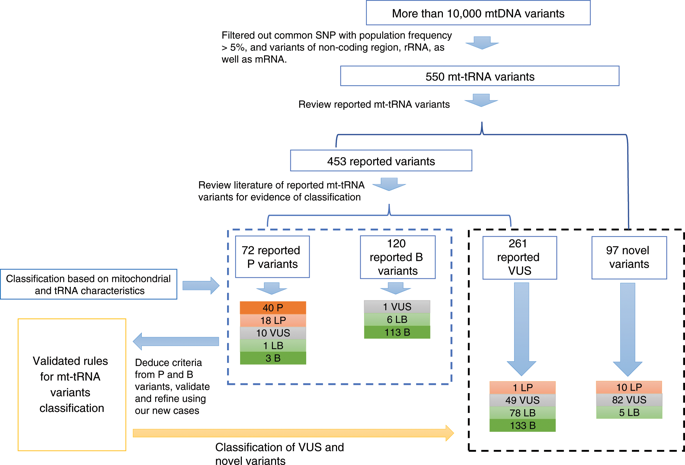当前位置:
X-MOL 学术
›
Genet. Med.
›
论文详情
Our official English website, www.x-mol.net, welcomes your
feedback! (Note: you will need to create a separate account there.)
Interpretation of mitochondrial tRNA variants.
Genetics in Medicine ( IF 6.6 ) Pub Date : 2020-01-22 , DOI: 10.1038/s41436-019-0746-0 Lee-Jun C Wong 1, 2 , Ting Chen 1, 3 , Jing Wang 1, 4 , Sha Tang 1, 5 , Eric S Schmitt 1, 2 , Megan Landsverk 1, 6 , Fangyuan Li 1, 7 , Yue Wang 1, 2 , Shulin Zhang 1, 8 , Victor Wei Zhang 1, 9 , William J Craigen 1, 2
Genetics in Medicine ( IF 6.6 ) Pub Date : 2020-01-22 , DOI: 10.1038/s41436-019-0746-0 Lee-Jun C Wong 1, 2 , Ting Chen 1, 3 , Jing Wang 1, 4 , Sha Tang 1, 5 , Eric S Schmitt 1, 2 , Megan Landsverk 1, 6 , Fangyuan Li 1, 7 , Yue Wang 1, 2 , Shulin Zhang 1, 8 , Victor Wei Zhang 1, 9 , William J Craigen 1, 2
Affiliation

|
PURPOSE
To develop criteria to interpret mitochondrial transfer RNA (mt-tRNA) variants based on unique characteristics of mitochondrial genetics and conserved structural/functional properties of tRNA.
METHODS
We developed rules on a set of established pathogenic/benign variants by examining heteroplasmy correlations with phenotype, tissue distribution, family members, and among unrelated families from published literature. We validated these deduced rules using our new cases and applied them to classify novel variants.
RESULTS
Evaluation of previously reported pathogenic variants found that 80.6% had sufficient evidence to support phenotypic correlation with heteroplasmy levels among and within families. The remaining variants were downgraded due to the lack of similar evidence. Application of the verified criteria resulted in rescoring 80.8% of reported variants of uncertain significance (VUS) to benign and likely benign. Among 97 novel variants, none met pathogenic criteria. A large proportion of novel variants (84.5%) remained as VUS, while only 10.3% were likely pathogenic. Detection of these novel variants in additional individuals would facilitate their classification.
CONCLUSION
Proper interpretation of mt-tRNA variants is crucial for accurate clinical diagnosis and genetic counseling. Correlations with tissue distribution, heteroplasmy levels, predicted perturbations to tRNA structure, and phenotypes provide important evidence for determining the clinical significance of mt-tRNA variants.
中文翻译:

解释线粒体 tRNA 变体。
目的 根据线粒体遗传学的独特特征和 tRNA 的保守结构/功能特性,制定解释线粒体转移 RNA (mt-tRNA) 变体的标准。方法 我们通过检查与已发表文献中的表型、组织分布、家族成员和不相关家族之间的异质性相关性,制定了关于一组已确定的致病/良性变异的规则。我们使用我们的新案例验证了这些推导出的规则,并将它们应用于对新变体进行分类。结果 对先前报道的致病变异的评估发现,80.6% 有足够的证据支持与家族之间和家族内部的异质性水平的表型相关性。由于缺乏类似的证据,其余变种被降级。应用经过验证的标准导致重新评分 80。8% 报告的具有不确定意义 (VUS) 的变异为良性且可能为良性。在 97 个新变体中,没有一个符合致病标准。大部分新变体 (84.5%) 仍然是 VUS,而只有 10.3% 可能是致病性的。在其他个体中检测这些新变体将有助于它们的分类。结论 正确解释 mt-tRNA 变体对于准确的临床诊断和遗传咨询至关重要。与组织分布、异质性水平、对 tRNA 结构的预测扰动和表型的相关性为确定 mt-tRNA 变体的临床意义提供了重要证据。5%) 仍然是 VUS,而只有 10.3% 可能是致病性的。在其他个体中检测这些新变体将有助于它们的分类。结论 正确解释 mt-tRNA 变体对于准确的临床诊断和遗传咨询至关重要。与组织分布、异质性水平、对 tRNA 结构的预测扰动和表型的相关性为确定 mt-tRNA 变体的临床意义提供了重要证据。5%) 仍然是 VUS,而只有 10.3% 可能是致病性的。在其他个体中检测这些新变体将有助于它们的分类。结论 正确解释 mt-tRNA 变体对于准确的临床诊断和遗传咨询至关重要。与组织分布、异质性水平、对 tRNA 结构的预测扰动和表型的相关性为确定 mt-tRNA 变体的临床意义提供了重要证据。
更新日期:2020-01-22
中文翻译:

解释线粒体 tRNA 变体。
目的 根据线粒体遗传学的独特特征和 tRNA 的保守结构/功能特性,制定解释线粒体转移 RNA (mt-tRNA) 变体的标准。方法 我们通过检查与已发表文献中的表型、组织分布、家族成员和不相关家族之间的异质性相关性,制定了关于一组已确定的致病/良性变异的规则。我们使用我们的新案例验证了这些推导出的规则,并将它们应用于对新变体进行分类。结果 对先前报道的致病变异的评估发现,80.6% 有足够的证据支持与家族之间和家族内部的异质性水平的表型相关性。由于缺乏类似的证据,其余变种被降级。应用经过验证的标准导致重新评分 80。8% 报告的具有不确定意义 (VUS) 的变异为良性且可能为良性。在 97 个新变体中,没有一个符合致病标准。大部分新变体 (84.5%) 仍然是 VUS,而只有 10.3% 可能是致病性的。在其他个体中检测这些新变体将有助于它们的分类。结论 正确解释 mt-tRNA 变体对于准确的临床诊断和遗传咨询至关重要。与组织分布、异质性水平、对 tRNA 结构的预测扰动和表型的相关性为确定 mt-tRNA 变体的临床意义提供了重要证据。5%) 仍然是 VUS,而只有 10.3% 可能是致病性的。在其他个体中检测这些新变体将有助于它们的分类。结论 正确解释 mt-tRNA 变体对于准确的临床诊断和遗传咨询至关重要。与组织分布、异质性水平、对 tRNA 结构的预测扰动和表型的相关性为确定 mt-tRNA 变体的临床意义提供了重要证据。5%) 仍然是 VUS,而只有 10.3% 可能是致病性的。在其他个体中检测这些新变体将有助于它们的分类。结论 正确解释 mt-tRNA 变体对于准确的临床诊断和遗传咨询至关重要。与组织分布、异质性水平、对 tRNA 结构的预测扰动和表型的相关性为确定 mt-tRNA 变体的临床意义提供了重要证据。











































 京公网安备 11010802027423号
京公网安备 11010802027423号